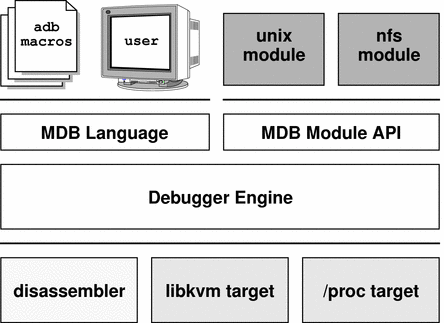|
|||
|
4. Using MDB Commands Interactively 9. Debugging With the Kernel Memory Allocator |
Building BlocksThe target is the program being inspected by the debugger. MDB currently provides support for the following types of targets:
Each target exports a standard set of properties, including one or more address spaces, one or more symbol tables, a set of load objects, and a set of threads. Figure 2-1 shows an overview of the MDB architecture, including two of the built-in targets and a pair of sample modules. A debugger command, or dcmd (pronounced dee-command) in MDB terminology, is a routine in the debugger that can access any of the properties of the current target. MDB parses commands from standard input, then executes the corresponding dcmds. Each dcmd can also accept a list of string or numerical arguments, as shown in Syntax. MDB contains a set of built-in dcmds that are always available. These built-in dcmds are described in Chapter 5, Built-In Commands. You can also extend the capabilities of MDB by writing dcmds using a programming API provided with MDB. A walker is a set of routines that describe how to walk, or iterate, through the elements of a particular program data structure. A walker encapsulates the data structure's implementation from dcmds and from MDB. You can use walkers interactively, or you can use walkers as primitives to build other dcmds or walkers. As with dcmds, you can extend MDB by implementing additional walkers as part of a debugger module. A debugger module, or dmod (pronounced dee-mod), is a dynamically loaded library that contains a set of dcmds and walkers. During initialization, MDB attempts to load dmods corresponding to the load objects present in the target. You can subsequently load or unload dmods at any time while running MDB. MDB provides a set of standard dmods for debugging the Solaris kernel. A macro file is a text file that contains a set of commands to execute. Macro files are typically used to automate the process of displaying a simple data structure. MDB provides complete backward compatibility for the execution of macro files written for adb. The set of macro files provided with the Solaris installation can therefore be used with either tool. Figure 2-1 MDB architecture
|
||
|